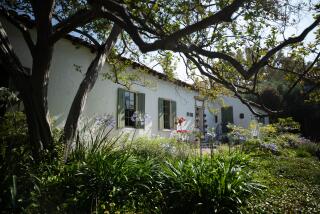San Andreas Presents Golden Past : Calaveras County Museum Pictures Mother Lode Town
- Share via
SAN ANDREAS, Calif. — The huge blowup of a striking photograph of this Mother Lode town’s Main Street on election day 1892 takes up an entire wall in the old courthouse.
In the photo, banners for opposing candidates strung from one side of the street to the other proclaim:
“Tariff Reform . . . Cleveland and Stevenson” and “Protection to American Industries . . . Harrison and Reid.”
Democrats Grover Cleveland and Adlai E. Stevenson were elected President and vice president that day, and Republicans Benjamin Harrison and Whitelaw Reid lost.
Election Day
“It was Election Day and the saloons were closed. Men stand outside business establishments on Main Street in the picture. You don’t see any women. Women couldn’t vote then. And, let’s face it, in 1892, women were not allowed to stand around like that,” noted Ruth Matson, 67, curator of the Calaveras County Courthouse Museum.
By looking closely at the photo, Matson observed, you can tell that someone had died in San Andreas on or shortly before Election Day. How?
“By the Message Tree,” she replied. “Look out the window. The same tree still stands on Main Street, and as you can see, the tradition continues to this day.”
Sure enough. There was a note posted on the Message Tree outside
the window reporting a death in town, the mortuary handling arrangements and the time and place of the funeral--just the way it was done 97 years ago.
There are also Chinese trees of heaven in the old photograph, and those trees still line the streets of San Andreas. They are all over the Mother Lode, a legacy of the Chinese miners, who believed that the trees protected them and brought them good luck. The miners carried seedlings with them when they came here from China and planted the trees everywhere they went.
The old courthouse complex consists of three 19th-Century structures: the Odd Fellows Hall built in 1856, the Courthouse/County Jail (1866) and the Hall of Records (1893). They all are part of the same building now, thanks to various construction projects over the years.
It’s owned by Calaveras County but operated as a museum by the 600-member Calaveras County Historical Society. For a museum in a town of 1,900 and serving a sparsely populated county (16,000 residents), it has outstanding graphics, exhibits and artifacts.
Trials in Old Court
Trials still are held in the old courtroom when cases bunch up in the new courthouse. When the courtroom is not in use, it becomes the museum’s centerpiece. The museum contains numerous relics of gold-rush days, including valuable gold nuggets and mining equipment, such as sluice boxes, rockers, cradles, bows, baskets and pans.
Antique tools from farms now inundated by Melones Lake reservoir are mounted on barn doors. One small room has statues, the Stations of the Cross and the altar from a Catholic Church that was in a town inundated by Lake Comanche reservoir. The museum has a sizable Miwok Indian collection, an 1880s general store and much, much more.
Black Bart and many other notorious outlaws were prisoners in the county jail’s five primitive cells, used until 1964. Several of the prisoners went to the gallows at the county’s hanging grounds in the courthouse yard.
Three murderers who were strung up are buried in the yard in unmarked graves. An 8-foot-high native-stone wall embraces the courthouse yard. It was put up by Chinese laborers.
Movie Site
The courthouse has a great winding staircase to the second floor. Over the years, many Hollywood movies have been filmed in the building.
“Randolph Scott was making a movie in the jailhouse when it was still in use. Only one prisoner was in the cell at the time--and he was drunk,” Ruth Matson recalled. “Every time they would start shooting a scene, he would yell, ‘Give ‘em hell, Randy.’ It required several takes before the prisoner kept quiet and the movie people were satisfied with what they had shot.”
More to Read
Sign up for Essential California
The most important California stories and recommendations in your inbox every morning.
You may occasionally receive promotional content from the Los Angeles Times.










